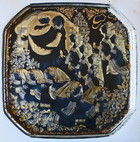Bjorn Wiinblad
(1918-2006)
Read no further if you like your art deep and profound. Danish Artist Bjorn Wiinblad made things, which beguiled the eye with their fanciful forms, vibrant colors, and gleaming surfaces. All he turned his hand to had a touch of whimsy, whether it was illustrations of the fairytales of Hans Christian Anderson, costumes and sets for Shakespeare’s A Midsummer Night’s Dream, posters of clowns and ballerinas for Copenhagen’s Tivoli Gardens amusement park and the Royal Danish Ballet, or a 1986 postage stamp of a woman and a bird. Wiinblad is best known for his work in ceramics: everything from horse-and-rider candlesticks and head-shaped vases to gilded porcelain plates of the Christmas Story and cut-glass plaques of the Parables.
The decorative arts would have lost a major talent had Wiinblad remained a typesetter, a trade to which all the young males of his family were traditionally apprenticed. He displayed a talent for drawing at an early age, so, artistic fancy ultimately triumphed over business sense, and Wiinblad enrolled in painting courses at the Danish Royal Academy of the Arts. For a time, he toyed with the idea of becoming an architect, even a musician, then, switched to pottery-making. By special arrangement with the Lars Syberg Studio in Taastrup, near Copenhagen, Wiinblad was able to fire ceramics after business hours and realize some of the unconventional designs floating around in his head.
Wiinblad opened his own studio in 1952 and was making winsome figurative pieces for the Nymolle ceramic works, when he was visited in 1957 by German Businessman Philip Rosenthal, who was developing product lines for the famous German porcelain company that bears his family name. In 1950, Rosenthal had joined the firm, established by his father in the late 19th century, determined to shake up its staid image. He saw a place for Wiinblad in the new Rosenthal design team, which included notable international artists like Raymond Loewy, Raymond Peynet, and Tapio Wirkkala. Their mission was to create home decor pieces and functional flatware with a contemporary flair for a special Rosenthal Studio-Line, launched in 1971.
That same year, Wiinblad designed the first of 24 porcelain plates for the company, devoted to Christmas themes, a perennial favorite of china collectors. There are Madonnas, Angels and Wisemen in plenty in his first set of twelve pieces, rendered with the round-faced, cartoon-like features typical of Wiinblad's figures, all decked out in richly-colored garments and framed by gilded arabesque patterns. Wiinblad expanded the traditional seasonal repertoire to include images of the Flight into Egypt, the Christ Child in the Temple, and the Baptism of Jesus. The second set of twelve plates, begun in 1983, illustrated Christmas Carols, beginning with Silent Night. It was a theme close to the heart of this music lover, who hoped to capture, in his words, “the pictures that form in our minds, when we close our eyes and listen to the Christmas carol.”
The Sacred Art Pilgrim Collection has a full set of six plaques from another Rosenthal series on biblical themes, which Wiinblad began in 1982, entitled, “The Parables in Glass.” The Danish designer illustrates Jesus’ stories of the Prodigal Son, the Good Samaritan, the Vineyard Laborers, the Fisherman and his Net, Lazarus and the Rich Man, and the Wise and Foolish Virgins in the unusual medium of cut-glass, bas relief panels. They are trimmed in gold and mounted on metal sheets, painted with silhouettes in blue or black. The onetime illustrator of the Thousand and One Nights loved the art of Asia, and the figure arrangements in his parable plaques recall the miniature paintings of Persia and the Mughal Empire.
Wiinblad’s joy in art-making earned him the nickname, the Merry Son of Nature. For some viewers, his ceramic works, no doubt, seem so sweetly sentimental they border on kitsch, but the Danish designer never aspired to make “great” art. He set himself the task of creating beautiful objects, which delight us by their very accessibility. In sacred works like “The Parables in Glass,” he invites us to see these gospel narratives with the innocent eyes of children--and, lest we forget, “of such is the kingdom of heaven (Matthew 19:14).”
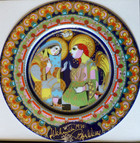
The Annunciation (1975)
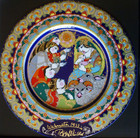
Adoration of the Shepherds (1977)
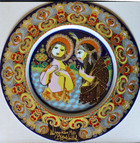
The Baptism of Christ (1982)
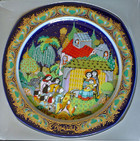
Silent Night (1983)
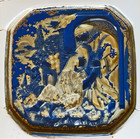
The Parable of the Prodigal Son (1982)

The Parable of the Good Samaritan (1983)
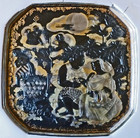
The Parable of the Vineyard Laborers (1984)
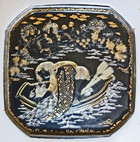
The Parable of the Fisherman & the Net (1985)
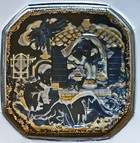
The Parable of Lazarus & the Rich Man (1986)
